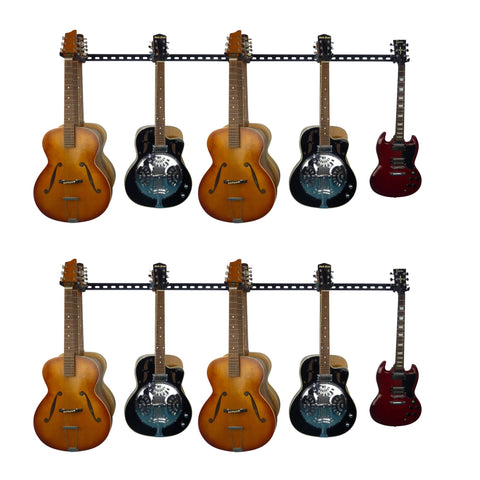
Tips for Storing Vintage Guitars and Ukuleles
Share
Whether you are a seasoned collector, a musician, or simply someone who appreciates the vintage charm of guitars and ukuleles, proper storage is crucial to preserve these cherished instruments. Storing vintage guitars and ukuleles requires careful consideration to maintain their condition over time. In this article, we will share valuable tips on how to store your vintage guitars and ukuleles effectively.
1. Choose the Right Location
The first step in storing your vintage guitars and ukuleles is selecting an appropriate location. Avoid areas with extreme temperature fluctuations, high humidity levels, or direct sunlight exposure. A cool, dry, and stable environment is ideal for preserving the wood and strings of your instruments.
2. Invest in Quality Guitar and Ukulele Wall Mounts
To save space and showcase your vintage guitars and ukuleles elegantly, consider using guitar wall mounts or ukulele wall hangers. These wall mounts not only provide a secure storage solution but also add a decorative touch to your space. Look for uku wall mounts or guitar wall hangers designed to hold the weight of your instruments securely.
3. Check for Nitrocellulose Lacquer
Nitrocellulose lacquer is softer and more susceptible to damage than modern finishes. It can easily be scratched, dented, or worn through. It can also react with certain chemicals found in guitar stands, straps, and cases, causing the finish to become sticky or to deteriorate. Use stands and hangers with nitro-safe materials.
GearHooks guitar rack hooks are coated with Silicone which will not react with 'Nitro' and is safe to use with vintage guitars and ukuleles. See the notes at the end of this article that talk about Nitrocellulose Lacquer on Vintage Guitars and Ukuleles.
3. Maintain Proper Humidity Levels
Humidity control is essential for preventing warping, cracking, or other damage to your vintage guitars and ukuleles. Invest in a hygrometer to monitor humidity levels in the storage area. Aim for a relative humidity level of around 45% to 55% to keep your instruments in optimal condition.
4. Clean and Condition Your Instruments Regularly
Regular maintenance is key to preserving the appearance and playability of your vintage guitars and ukuleles. Use a soft cloth to clean the surfaces of the instruments and consider using a high-quality wood conditioner to nourish the wood and prevent drying out.
5. Store Guitars and Ukuleles in Hard Cases
If you only have a couple of valuable instruments you can store your vintage guitars and ukuleles in hard cases to protect them from dust, moisture, and accidental damage. Ensure that the cases are clean and free from any debris that could scratch the instruments.
If you have a lot of instruments this isn't a practical option. A better option might be to use the kind of hangers that allow several instruments be stored on each hook.
6. Avoid Hanging Instruments in High-Traffic Areas
While wall mounts are a convenient storage solution, avoid hanging your vintage guitars and ukuleles in high-traffic areas where they could be bumped or knocked over. Opt for a quiet and secure spot to display your instruments.
Gearhooks guitar and ukulele racks can be fitted in just 1 meter of wall space which gives you plenty of options.
7. Check and Adjust String Tension
String tension can affect the neck and overall condition of your vintage guitars and ukuleles. Periodically check the string tension and make adjustments as needed to prevent excessive strain on the instrument.
8. Rotate Your Instruments Periodically
To prevent uneven wear and exposure, consider rotating your vintage guitars and ukuleles periodically. This practice can help distribute any environmental effects more evenly across your collection.
9. Keep Accessories Organized
Storing vintage guitars and ukuleles also means organising accessories like picks, strings, and tuners. Use storage bins or drawers to keep these items within easy reach and maintain a clutter-free storage area.
10. Inspect for Signs of Damage
Regularly inspect your vintage guitars and ukuleles for signs of damage such as cracks, loose components, or changes in the instrument's tone. Address any issues promptly to prevent further deterioration.
11. Consider Professional Maintenance
If you notice significant issues or if your vintage guitars and ukuleles require specialised care, consider consulting a professional luthier or instrument technician. Professional maintenance can help prolong the lifespan of your cherished instruments.
12. Play Your Instruments Regularly
Finally, one of the best ways to maintain the condition of your vintage guitars and ukuleles is to play them regularly. Regular playing helps keep the wood and strings in good condition and allows you to appreciate the beautiful sound of your instruments.
Discover the Joy of Well-Preserved Vintage Guitars and Ukuleles
By following these tips for storing vintage guitars and ukuleles, you can enjoy your cherished instruments for years to come. Invest in quality guitar wall mounts or ukulele wall hangers, maintain proper humidity levels, and stay proactive in caring for your collection. With the right storage solutions and maintenance routine, your vintage guitars and ukuleles will continue to inspire music and admiration.
Further Reading:
Nitrocellulose Lacquer on Guitars
Nitrocellulose lacquer is widely used on guitars for its aesthetic and tonal qualities. Here's a detailed look at its application on guitars and important considerations:
Characteristics
- Tone Enhancement: It is believed to allow the wood to "breathe," potentially enhancing the instrument's resonance and tonal qualities.
- Aesthetics: Provides a high-gloss, vintage appearance that many guitar enthusiasts and players appreciate.
- Aging: Develops a natural patina and fine cracks (known as "checking") over time, which is often seen as adding character to the instrument.
Application
- Spray Application: Typically applied using spray equipment for an even coat.
- Multiple Thin Coats: Several thin coats are applied, with sanding between coats to achieve a smooth finish.
- Polishing: Final coats are buffed and polished to a high gloss.
Considerations and Precautions
Handling and Maintenance
- Delicate Finish: Nitrocellulose lacquer is softer and more susceptible to damage than modern finishes. It can easily be scratched, dented, or worn through.
- Chemical Sensitivity: It can react with certain chemicals found in guitar stands, straps, and cases, causing the finish to become sticky or to deteriorate. Use stands and hangers with nitro-safe materials.
- Environmental Sensitivity: Temperature and humidity changes can affect the finish, leading to checking and shrinking.
Storage and Care
- Avoid Direct Sunlight: Prolonged exposure to sunlight can cause fading and excessive drying, leading to cracks.
- Controlled Environment: Keep the guitar in a stable environment with controlled humidity and temperature to minimize the risk of finish damage.
- Cleaning: Use only guitar-specific cleaning products. Avoid harsh chemicals and household cleaners, which can damage the finish.
Repair and Restoration
- Easily Repairable: One of the advantages is that it can be repaired easily by reapplying additional lacquer or solvent to blend the damage.
- Professional Touch-Up: For significant damage, it's often best to seek professional help to ensure a seamless repair.
Common Issues
- Yellowing: Over time, nitrocellulose lacquer tends to yellow, which can alter the appearance of lighter-colored guitars.
- Checking: The finish can develop fine cracks due to temperature fluctuations, which is often considered desirable for vintage instruments but may not be for newer ones.
- Softening: Prolonged contact with certain plastics and synthetic materials can soften the lacquer, causing imprints or sticking.
Advantages
- Vintage Appeal: Highly valued for its vintage look and feel.
- Sound Quality: Preferred by many for its minimal impact on the natural resonance of the wood.
Disadvantages
- Durability: Less durable compared to modern polyurethane and polyester finishes.
- Maintenance: Requires more careful maintenance to keep it looking good.
In summary, while nitrocellulose lacquer is prized for its tonal properties and vintage aesthetic, it requires careful handling and maintenance to preserve its appearance and functionality on guitars. Musicians and collectors often accept these trade-offs for the unique benefits it provides.
Embark on a journey through the Shopify store of another user. Click here to visit their store. Please note that this is a promotional link, and we do not guarantee the content of the linked store.



